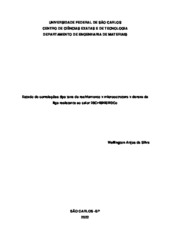| dc.contributor.author | Silva, Wellington Anjos | |
| dc.date.accessioned | 2022-10-11T17:22:59Z | |
| dc.date.available | 2022-10-11T17:22:59Z | |
| dc.date.issued | 2022-09-12 | |
| dc.identifier.citation | SILVA, Wellington Anjos. Estudo de correlações tipo taxa de resfriamento x microestrutura x dureza da liga resistente ao calor 28Cr48Ni5W3Co. 2022. Trabalho de Conclusão de Curso (Graduação em Engenharia de Materiais) – Universidade Federal de São Carlos, São Carlos, 2022. Disponível em: https://repositorio.ufscar.br/handle/ufscar/16852. | * |
| dc.identifier.uri | https://repositorio.ufscar.br/handle/ufscar/16852 | |
| dc.description.abstract | The 28Cr48Ni5W3Co alloy is widely used in furnace systems and various
petrochemical plant equipment. In this work, the directional solidification of this alloy
in a transient heat extraction regime was carried out, obtaining cooling rates according
to the dendritic length-scales and enabling a correlation between both. An analysis
was performed by sizing the secondary dendritic spacings (λ2) finding lower values (~
16 m) near the metal/mold interface and higher values along the solidification
direction (~ 120 m). The directionally solidified alloy casting showed an equiaxed
morphology, with dendritic growth along its entire length. The thermodynamic analysis
by CALPHAD method showed, from the Scheil model, that at the time of the first
measurements with the thermocouples inside the casting there was no eutectic liquid
present, resulting in rates that do not describe the beginning of solidification, but
instead represent a global processing cooling rate. Within the range of the obtained
cooling rates (from 0.03 ºC/s to 22 ºC/s), the analyzes revealed that increasing the
cooling rate, in addition to reducing the secondary spacing, reduces the carbide size.
The microstructure formed is composed of an austenitic matrix rich in nickel and
chromium with carbides precipitated at the interdendritic portions. The secondary
dendritic spacings were related to the cooling rate, and with this, an adjusted equation
was generated that described the behavior of the microstructure along the casting.
Finally, the Brinell hardness results indicated that there was a high correlation with the
cooling rate. | eng |
| dc.description.sponsorship | Não recebi financiamento | por |
| dc.language.iso | por | por |
| dc.publisher | Universidade Federal de São Carlos | por |
| dc.rights | Attribution-NonCommercial-NoDerivs 3.0 Brazil | * |
| dc.rights.uri | http://creativecommons.org/licenses/by-nc-nd/3.0/br/ | * |
| dc.subject | 28Cr48Ni5W3Co | eng |
| dc.subject | Directional solidification | eng |
| dc.subject | Microstructures | eng |
| dc.subject | Interdendritic spacing | eng |
| dc.subject | Cooling rate | eng |
| dc.subject | Heat resistant alloys | eng |
| dc.title | Estudo de correlações tipo taxa de resfriamento x microestrutura x dureza da liga resistente ao calor 28Cr48Ni5W3Co | por |
| dc.title.alternative | Study of correlations type cooling rate x microstructure x hardness of the heat resistant 28Cr48Ni5W3Co alloy | eng |
| dc.type | TCC | por |
| dc.contributor.advisor1 | Spinelli, José Eduardo | |
| dc.contributor.advisor1Lattes | http://lattes.cnpq.br/8882038118634925 | por |
| dc.contributor.advisor-co1 | Sousa, Sarah Maria de Albuquerque | |
| dc.description.resumo | A liga 28Cr48Ni5W3Co é muito aplicada em sistemas de fornos e diversos
equipamentos de plantas petroquímicas. No entanto, aspectos relacionados a sua
solidificação são pouco conhecidos. Neste trabalho de TCC foi estudado a
solidificação direcional desta liga em regime transiente de extração de calor, obtendo
taxa de resfriamento de acordo com a microestrutura e possibilitando uma correlação
entre ambas. Uma análise foi realizada dimensionando os espaçamentos dendríticos
secundários (λ2) encontrando valores menores (~ 16 m) próximos à interface
metal/molde e maiores valores (~ 120 m) no decorrer do sentido de solidificação. A
liga solidificada direcionalmente apresentou macromorfologia completamente
equiaxial, com micromorfologia dendrítica em toda extensão do lingote. A análise
termodinâmica pelo método CALPHAD mostrou a partir do modelo de Scheil que o
intervalo de solidificação variou de 1298oC a 1341oC. Dessa forma, na primeira
medição conseguida pelos termopares no dispositivo experimental já não havia mais
líquido eutético, resultando em taxas que não descrevem o início da solidificação,
porém fazem parte do período posterior do processo, representando o mesmo de
forma global. Dentro do intervalo das taxas de resfriamento obtidas (0,03 ºC/s – 22
ºC/s), as análises revelaram que aumentar a taxa de resfriamento além de reduzir o
espaçamento secundário, reduz o tamanho dos carbonetos. A microestrutura formada
é composta por uma matriz austenítica rica em níquel e cromo com carbonetos
precipitados nas regiões interdendríticas. Foram relacionados espaçamentos
dendríticos secundários com a taxa de resfriamento, e com isso foi gerada uma
equação ajustada que descreve o comportamento da microestrutura ao longo do
lingote. E por fim os resultados dos ensaios de dureza Brinell indicam uma alta
correlação dessa propriedade com a taxa de resfriamento de processo. | por |
| dc.publisher.initials | UFSCar | por |
| dc.subject.cnpq | ENGENHARIAS::ENGENHARIA DE MATERIAIS E METALURGICA::METALURGIA FISICA | por |
| dc.publisher.address | Câmpus São Carlos | por |
| dc.publisher.course | Engenharia de Materiais - EMa | por |

